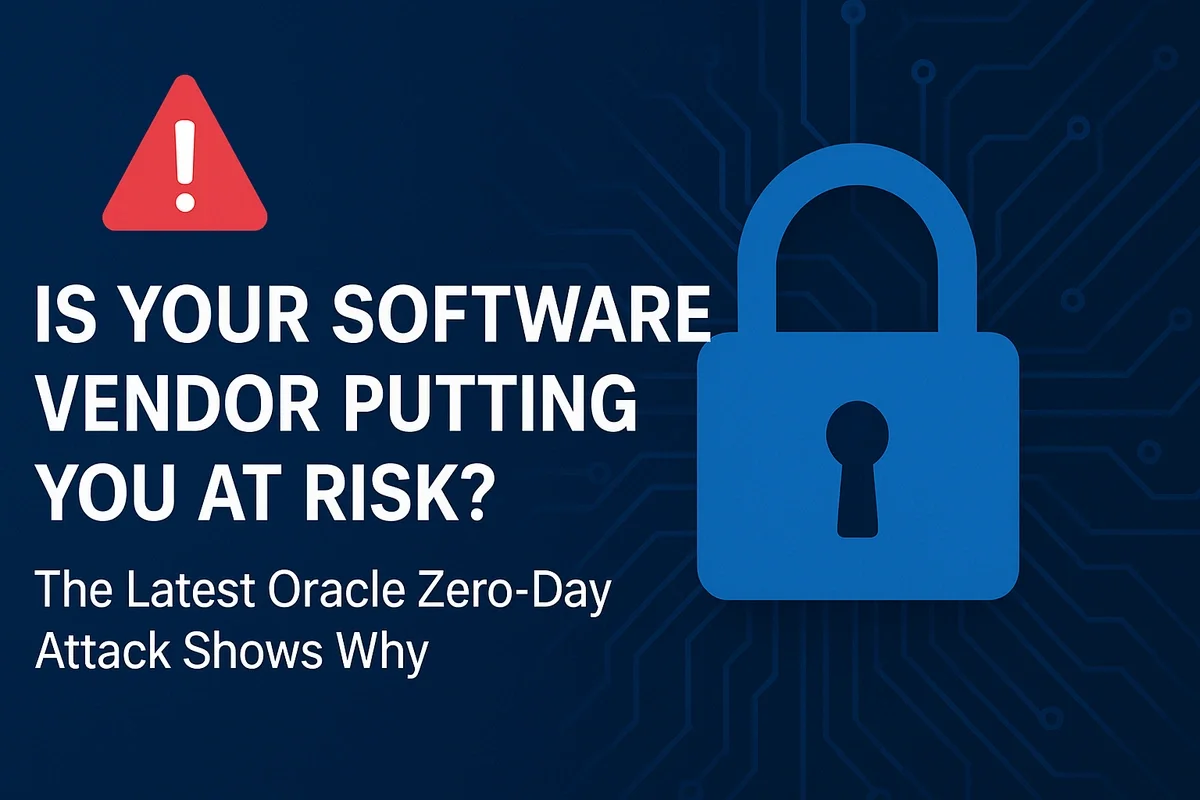
Oracle recently rushed out emergency patches for critical zero-day vulnerabilities in its E-Business Suite after active in-the-wild exploitation was detected. The incident highlights a simple truth: when vendors are attacked, your business can be exposed too. Here’s what you need to know — and the practical steps every SMB should take now.
What happened
In early October, multiple security vendors and news outlets reported that Oracle released emergency fixes for critical zero-day vulnerabilities in its E-Business Suite. These flaws allowed remote, unauthenticated attackers to run code on affected systems and were actively exploited by ransomware and extortion groups prior to patch availability. Oracle and security teams have published advisories and indicators of compromise to help affected customers identify abuse.
Why this matters to you: Oracle E-Business Suite is not just used by global enterprises — many mid-market organizations and MSP customers use third-party business applications (finance, HR, inventory, or CRM systems). A vulnerability in a vendor product can become a direct path into your data and operations if you rely on that software.
Why vendor vulnerabilities are a unique threat
- Scale: A single widely used product can expose thousands of customers at once.
- Privileged access: Business applications often store sensitive PII, payroll data, financial records, and integration credentials.
- Supply-chain ripple effect: An attacker who compromises a vendor or a vendor integration can move laterally into partner and customer environments.
- Rapid exploitation: When exploit code or indicators leak, attackers automatedly scan and hit vulnerable instances at scale.
Security researchers observed a pattern: threat actors exploited Oracle EBS zero-days to exfiltrate data and then sent extortion demands to victims. That sequence — exploit, data theft, extortion — is what makes vendor flaws especially dangerous.
Four practical steps to protect your business
You don’t need to be a security expert to reduce your vendor risk. Below are 4 practical actions any SMB can (and should) take immediately.
1. Inventory and prioritize your third-party apps
Make a simple list of the SaaS and on-prem applications your business depends on (payroll, CRM, finance, vendor portals). Mark which systems handle sensitive data or have privileged integrations (API keys, service accounts). Prioritize patching and monitoring for systems with the highest impact.
2. Patch fast — and verify
Treat vendor security advisories like urgent corporate mail. Subscribe to vendor security alerts and apply emergency patches quickly. If you can’t patch immediately, follow vendor mitigations (block specific endpoints, restrict access) and document timelines for remediation. Use scanning tools to verify whether the patch was applied successfully.
3. Limit and monitor integrations
Integrations between vendors and your environment are convenient — and risky. Limit integration permissions to the minimum required (principle of least privilege), rotate API keys and credentials regularly, and centralize logs for activity monitoring. If a vendor integration looks for or uses elevated rights, re-evaluate whether that access is necessary.
4. Require vendor security assurance
Ask your vendors for security documentation — SOC 2 reports, penetration test summaries, or evidence of secure development practices. In contracts, require timely breach notification and ask about incident response SLAs. If a vendor can’t demonstrate basic security hygiene, treat that as a risk factor in procurement decisions.
Checklist: Quick actions you can do this week
- Subscribe to security advisories for all critical vendors you use.
- Confirm whether you run Oracle E-Business Suite (or other enterprise apps) and check vendor advisories now.
- Apply emergency patches or follow vendor mitigations immediately.
- Rotate credentials used by vendor integrations (API keys, service accounts).
- Enable centralized logging and set alerts for unusual behavior coming from vendor integrations.
How an MSP like Riverside Technologies helps
Vendor vulnerabilities demand both technical and operational responses. Riverside Technologies can:
- Maintain an up-to-date inventory of your third-party software and integrations.
- Monitor vendor advisories and deploy emergency patches or mitigations on your behalf.
- Harden integration points, rotate credentials, and apply least-privilege access controls.
- Centralize logging, detect suspicious activity, and run tabletop exercises for vendor-related incidents.
If your business relies on third-party applications — and most do — don’t wait for a vendor breach to find out whether you’re vulnerable. Contact us for a free vendor-risk review and prioritized action plan.
Share this post
Tags
Need IT Support?
Let Riverside Technologies help your business with comprehensive IT solutions.
Contact Us Today